2003 FORD CROWN VICTORIA brakes
[x] Cancel search: brakesPage 153 of 248
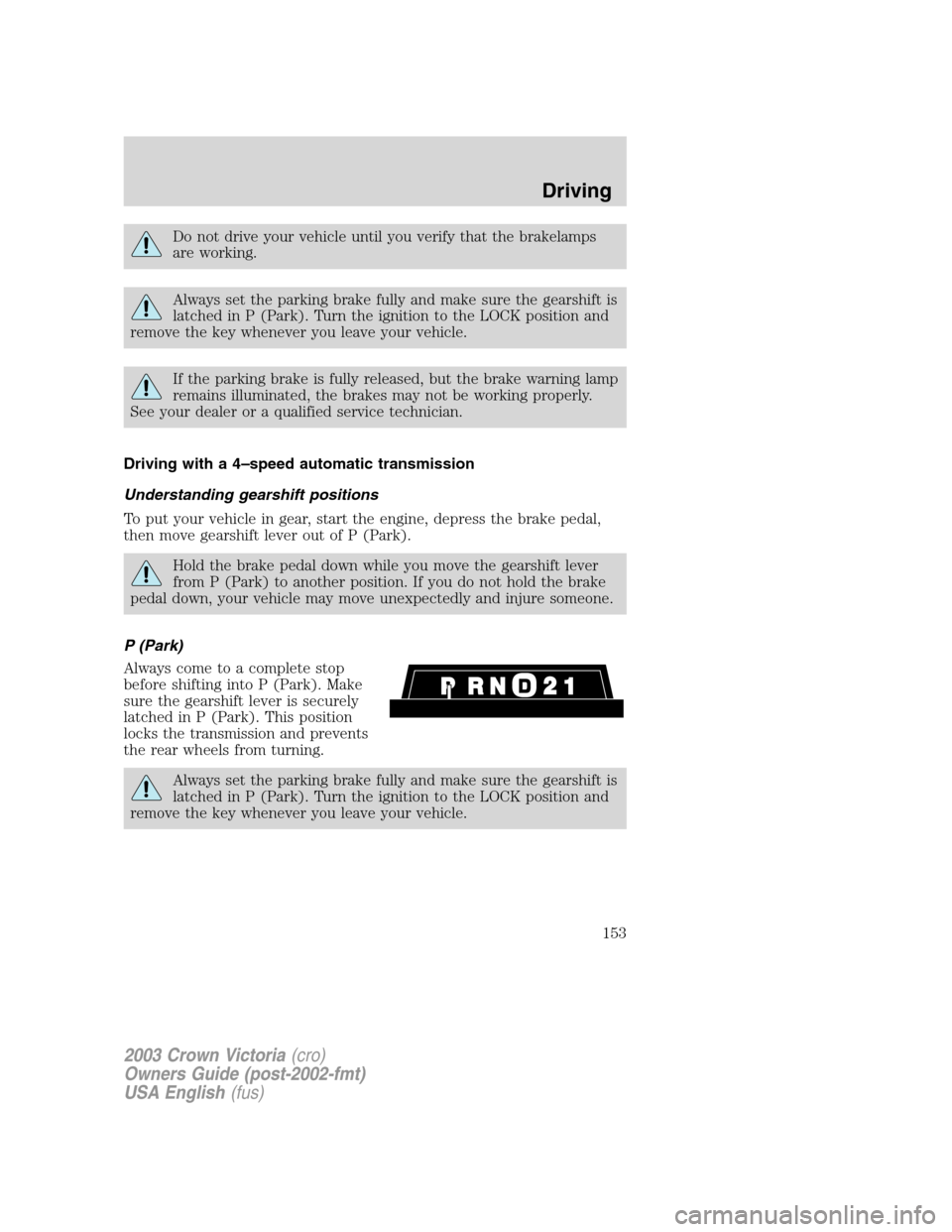
Do not drive your vehicle until you verify that the brakelamps
are working.
Always set the parking brake fully and make sure the gearshift is
latched in P (Park). Turn the ignition to the LOCK position and
remove the key whenever you leave your vehicle.
If the parking brake is fully released, but the brake warning lamp
remains illuminated, the brakes may not be working properly.
See your dealer or a qualified service technician.
Driving with a 4–speed automatic transmission
Understanding gearshift positions
To put your vehicle in gear, start the engine, depress the brake pedal,
then move gearshift lever out of P (Park).
Hold the brake pedal down while you move the gearshift lever
from P (Park) to another position. If you do not hold the brake
pedal down, your vehicle may move unexpectedly and injure someone.
P (Park)
Always come to a complete stop
before shifting into P (Park). Make
sure the gearshift lever is securely
latched in P (Park). This position
locks the transmission and prevents
the rear wheels from turning.
Always set the parking brake fully and make sure the gearshift is
latched in P (Park). Turn the ignition to the LOCK position and
remove the key whenever you leave your vehicle.
2003 Crown Victoria(cro)
Owners Guide (post-2002-fmt)
USA English(fus)
Driving
153
Page 156 of 248

If your vehicle gets stuck in mud or snow
If your vehicle gets stuck in mud or snow, it may be rocked out by
shifting from forward and reverse gears, stopping between shifts in a
steady pattern. Press lightly on the accelerator in each gear.
Do not rock the vehicle if the engine is not at normal operating
temperature or damage to the transmission may occur.
Do not rock the vehicle for more than a minute or damage to the
transmission and tires may occur, or the engine may overheat.
TRACTION-LOK AXLE (IF EQUIPPED)
This axle provides added traction on slippery surfaces, particularly when
one wheel is on a poor traction surface. Under normal conditions, the
Traction-Lok axle functions like a standard rear axle.
Extended use of other than the manufacturer’s specified size tires on a
Traction-Lok rear axle could result in a permanent reduction in
effectiveness. This loss of effectiveness does not affect normal driving
and should not be noticeable to the driver.
DRIVING THROUGH WATER
Do not drive quickly through standing water, especially if the depth is
unknown. Traction or brake capability may be limited and if the ignition
system gets wet, your engine may stall. Water may also enter your
engine’s air intake and severely damage your engine.
If driving through deep or standing water is unavoidable, proceed very
slowly. Never drive through water that is higher than the bottom of the
hubs (for trucks) or the bottom of the wheel rims (for cars).
Once through the water, always try the brakes. Wet brakes do not stop
the vehicle as effectively as dry brakes. Drying can be improved by
moving your vehicle slowly while applying light pressure on the brake
pedal.
Driving through deep water where the transmission vent tube is
submerged may allow water into the transmission and cause
internal transmission damage. Have the fluid checked and, if
water is found, replace the fluid.
VEHICLE LOADING
Before loading a vehicle, familiarize yourself with the following terms:
•Base Curb Weight:Weight of the vehicle including any standard
equipment, fluids, lubricants, etc. It does not include occupants or
aftermarket equipment.
2003 Crown Victoria(cro)
Owners Guide (post-2002-fmt)
USA English(fus)
Driving
156
Page 158 of 248
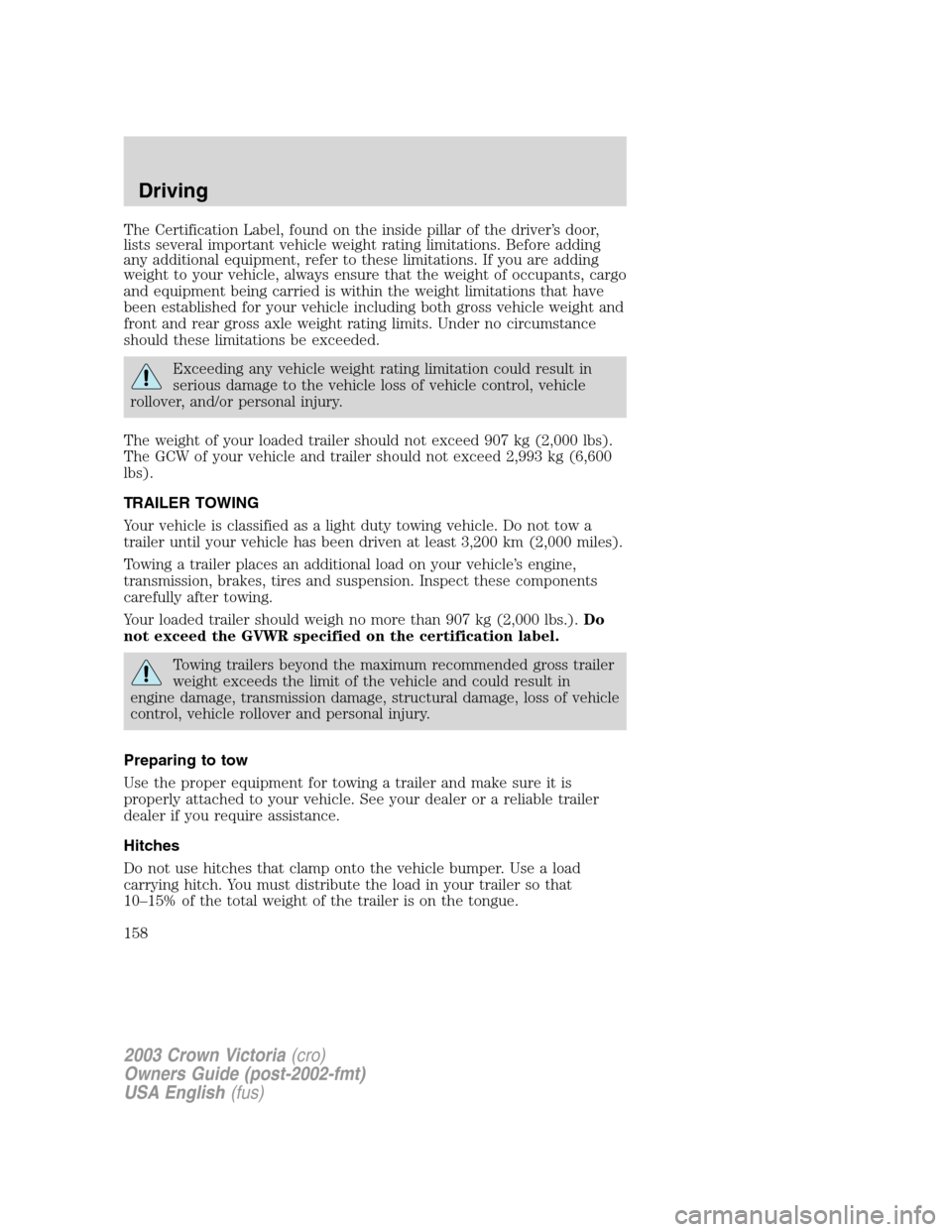
The Certification Label, found on the inside pillar of the driver’s door,
lists several important vehicle weight rating limitations. Before adding
any additional equipment, refer to these limitations. If you are adding
weight to your vehicle, always ensure that the weight of occupants, cargo
and equipment being carried is within the weight limitations that have
been established for your vehicle including both gross vehicle weight and
front and rear gross axle weight rating limits. Under no circumstance
should these limitations be exceeded.
Exceeding any vehicle weight rating limitation could result in
serious damage to the vehicle loss of vehicle control, vehicle
rollover, and/or personal injury.
The weight of your loaded trailer should not exceed 907 kg (2,000 lbs).
The GCW of your vehicle and trailer should not exceed 2,993 kg (6,600
lbs).
TRAILER TOWING
Your vehicle is classified as a light duty towing vehicle. Do not tow a
trailer until your vehicle has been driven at least 3,200 km (2,000 miles).
Towing a trailer places an additional load on your vehicle’s engine,
transmission, brakes, tires and suspension. Inspect these components
carefully after towing.
Your loaded trailer should weigh no more than 907 kg (2,000 lbs.).Do
not exceed the GVWR specified on the certification label.
Towing trailers beyond the maximum recommended gross trailer
weight exceeds the limit of the vehicle and could result in
engine damage, transmission damage, structural damage, loss of vehicle
control, vehicle rollover and personal injury.
Preparing to tow
Use the proper equipment for towing a trailer and make sure it is
properly attached to your vehicle. See your dealer or a reliable trailer
dealer if you require assistance.
Hitches
Do not use hitches that clamp onto the vehicle bumper. Use a load
carrying hitch. You must distribute the load in your trailer so that
10–15% of the total weight of the trailer is on the tongue.
2003 Crown Victoria(cro)
Owners Guide (post-2002-fmt)
USA English(fus)
Driving
158
Page 159 of 248
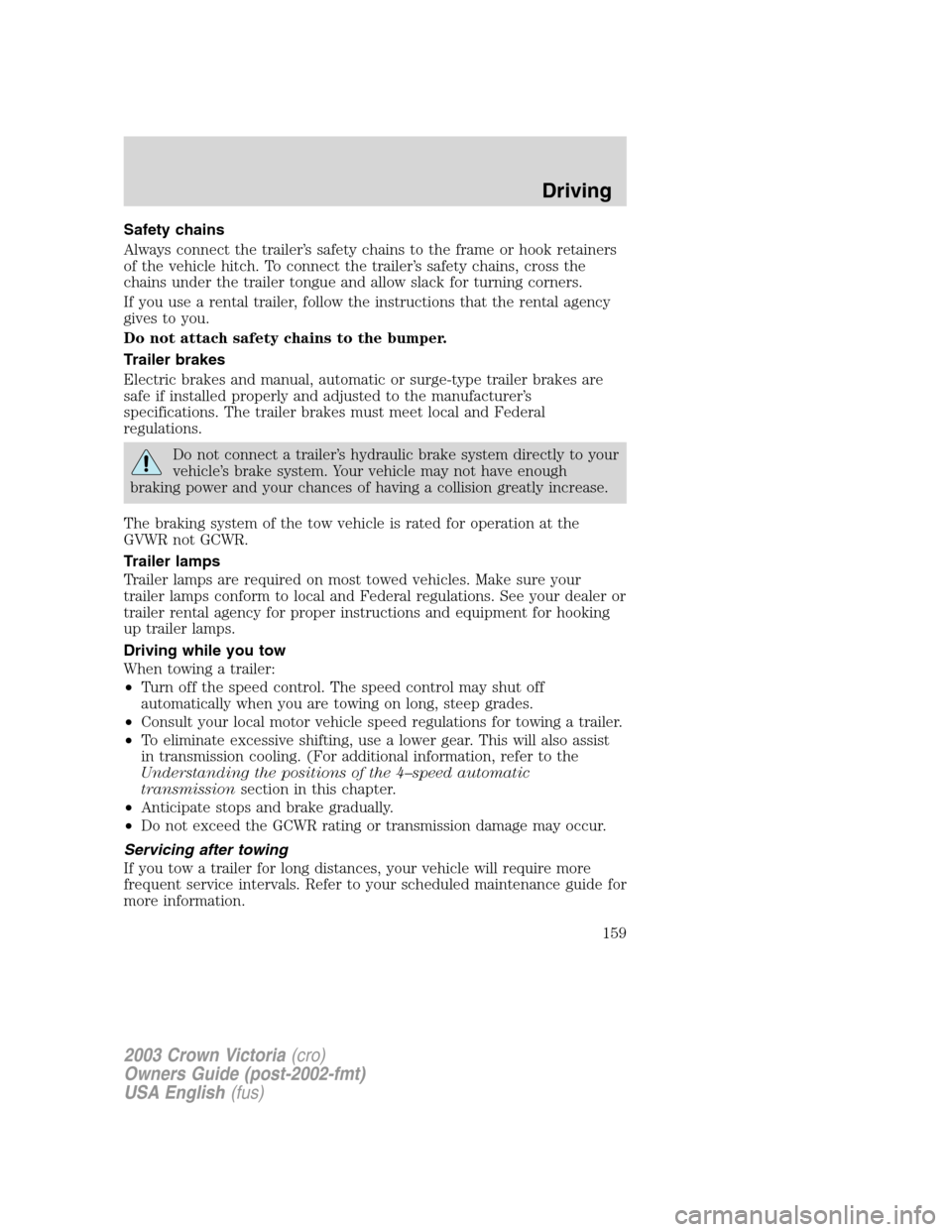
Safety chains
Always connect the trailer’s safety chains to the frame or hook retainers
of the vehicle hitch. To connect the trailer’s safety chains, cross the
chains under the trailer tongue and allow slack for turning corners.
If you use a rental trailer, follow the instructions that the rental agency
gives to you.
Do not attach safety chains to the bumper.
Trailer brakes
Electric brakes and manual, automatic or surge-type trailer brakes are
safe if installed properly and adjusted to the manufacturer’s
specifications. The trailer brakes must meet local and Federal
regulations.
Do not connect a trailer’s hydraulic brake system directly to your
vehicle’s brake system. Your vehicle may not have enough
braking power and your chances of having a collision greatly increase.
The braking system of the tow vehicle is rated for operation at the
GVWR not GCWR.
Trailer lamps
Trailer lamps are required on most towed vehicles. Make sure your
trailer lamps conform to local and Federal regulations. See your dealer or
trailer rental agency for proper instructions and equipment for hooking
up trailer lamps.
Driving while you tow
When towing a trailer:
•Turn off the speed control. The speed control may shut off
automatically when you are towing on long, steep grades.
•Consult your local motor vehicle speed regulations for towing a trailer.
•To eliminate excessive shifting, use a lower gear. This will also assist
in transmission cooling. (For additional information, refer to the
Understanding the positions of the 4–speed automatic
transmissionsection in this chapter.
•Anticipate stops and brake gradually.
•Do not exceed the GCWR rating or transmission damage may occur.
Servicing after towing
If you tow a trailer for long distances, your vehicle will require more
frequent service intervals. Refer to your scheduled maintenance guide for
more information.
2003 Crown Victoria(cro)
Owners Guide (post-2002-fmt)
USA English(fus)
Driving
159
Page 160 of 248
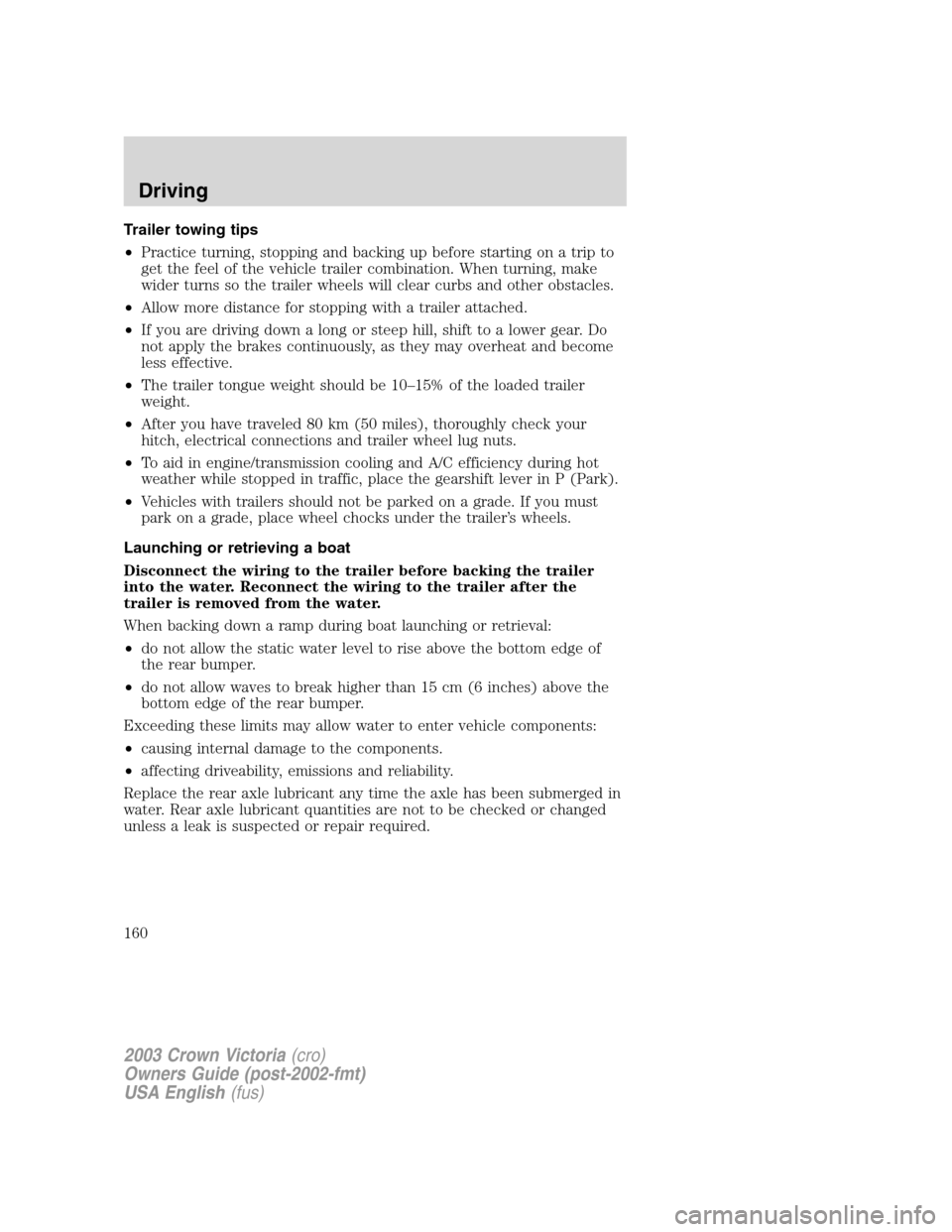
Trailer towing tips
•Practice turning, stopping and backing up before starting on a trip to
get the feel of the vehicle trailer combination. When turning, make
wider turns so the trailer wheels will clear curbs and other obstacles.
•Allow more distance for stopping with a trailer attached.
•If you are driving down a long or steep hill, shift to a lower gear. Do
not apply the brakes continuously, as they may overheat and become
less effective.
•The trailer tongue weight should be 10–15% of the loaded trailer
weight.
•After you have traveled 80 km (50 miles), thoroughly check your
hitch, electrical connections and trailer wheel lug nuts.
•To aid in engine/transmission cooling and A/C efficiency during hot
weather while stopped in traffic, place the gearshift lever in P (Park).
•Vehicles with trailers should not be parked on a grade. If you must
park on a grade, place wheel chocks under the trailer’s wheels.
Launching or retrieving a boat
Disconnect the wiring to the trailer before backing the trailer
into the water. Reconnect the wiring to the trailer after the
trailer is removed from the water.
When backing down a ramp during boat launching or retrieval:
•do not allow the static water level to rise above the bottom edge of
the rear bumper.
•do not allow waves to break higher than 15 cm (6 inches) above the
bottom edge of the rear bumper.
Exceeding these limits may allow water to enter vehicle components:
•causing internal damage to the components.
•affecting driveability, emissions and reliability.
Replace the rear axle lubricant any time the axle has been submerged in
water. Rear axle lubricant quantities are not to be checked or changed
unless a leak is suspected or repair required.
2003 Crown Victoria(cro)
Owners Guide (post-2002-fmt)
USA English(fus)
Driving
160
Page 222 of 248
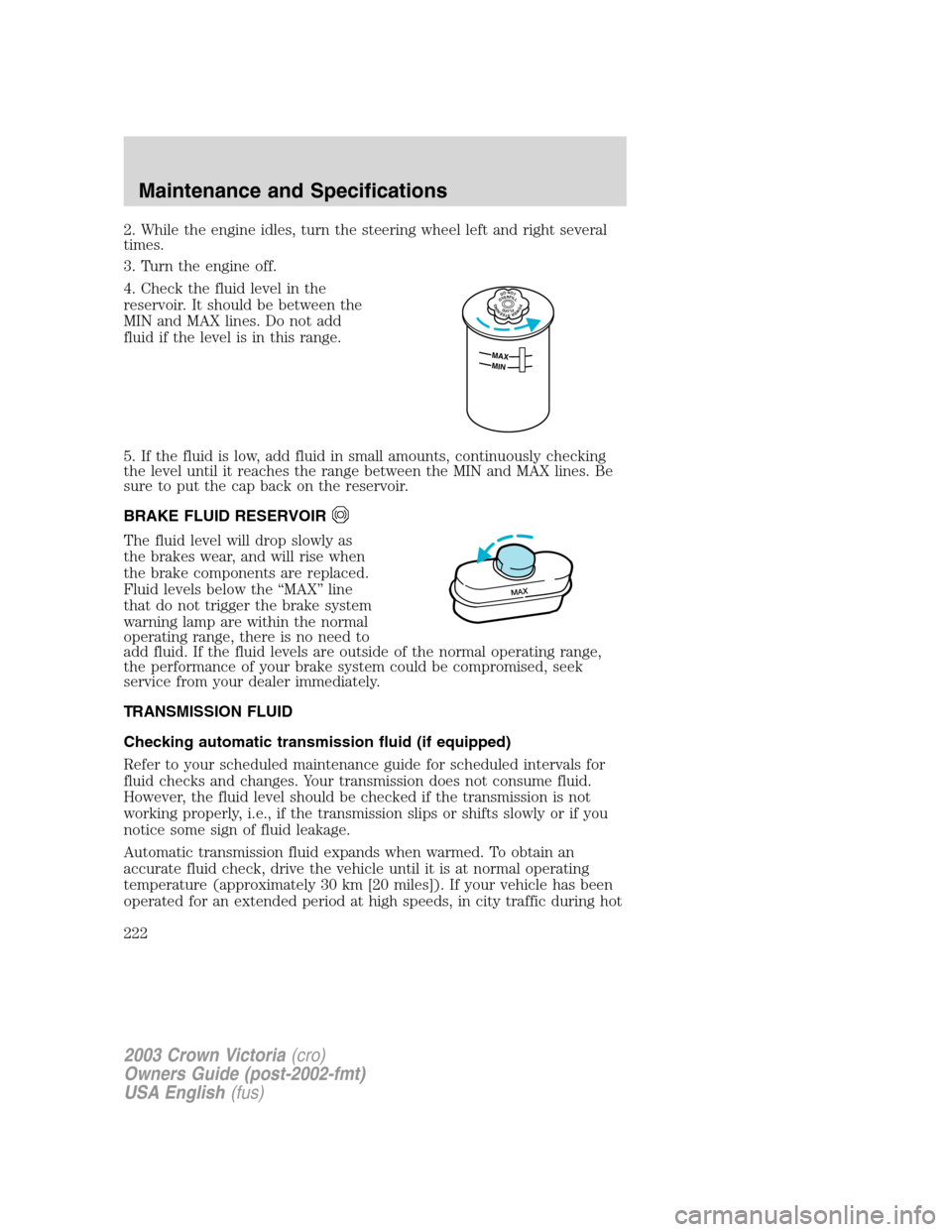
2. While the engine idles, turn the steering wheel left and right several
times.
3. Turn the engine off.
4. Check the fluid level in the
reservoir. It should be between the
MIN and MAX lines. Do not add
fluid if the level is in this range.
5. If the fluid is low, add fluid in small amounts, continuously checking
the level until it reaches the range between the MIN and MAX lines. Be
sure to put the cap back on the reservoir.
BRAKE FLUID RESERVOIR
The fluid level will drop slowly as
the brakes wear, and will rise when
the brake components are replaced.
Fluid levels below the“MAX”line
that do not trigger the brake system
warning lamp are within the normal
operating range, there is no need to
add fluid. If the fluid levels are outside of the normal operating range,
the performance of your brake system could be compromised, seek
service from your dealer immediately.
TRANSMISSION FLUID
Checking automatic transmission fluid (if equipped)
Refer to your scheduled maintenance guide for scheduled intervals for
fluid checks and changes. Your transmission does not consume fluid.
However, the fluid level should be checked if the transmission is not
working properly, i.e., if the transmission slips or shifts slowly or if you
notice some sign of fluid leakage.
Automatic transmission fluid expands when warmed. To obtain an
accurate fluid check, drive the vehicle until it is at normal operating
temperature (approximately 30 km [20 miles]). If your vehicle has been
operated for an extended period at high speeds, in city traffic during hot
DONOTOVERFILLPOWERSTEERINGFLUID
MAX
MIN
MAX
2003 Crown Victoria(cro)
Owners Guide (post-2002-fmt)
USA English(fus)
Maintenance and Specifications
222
Page 240 of 248
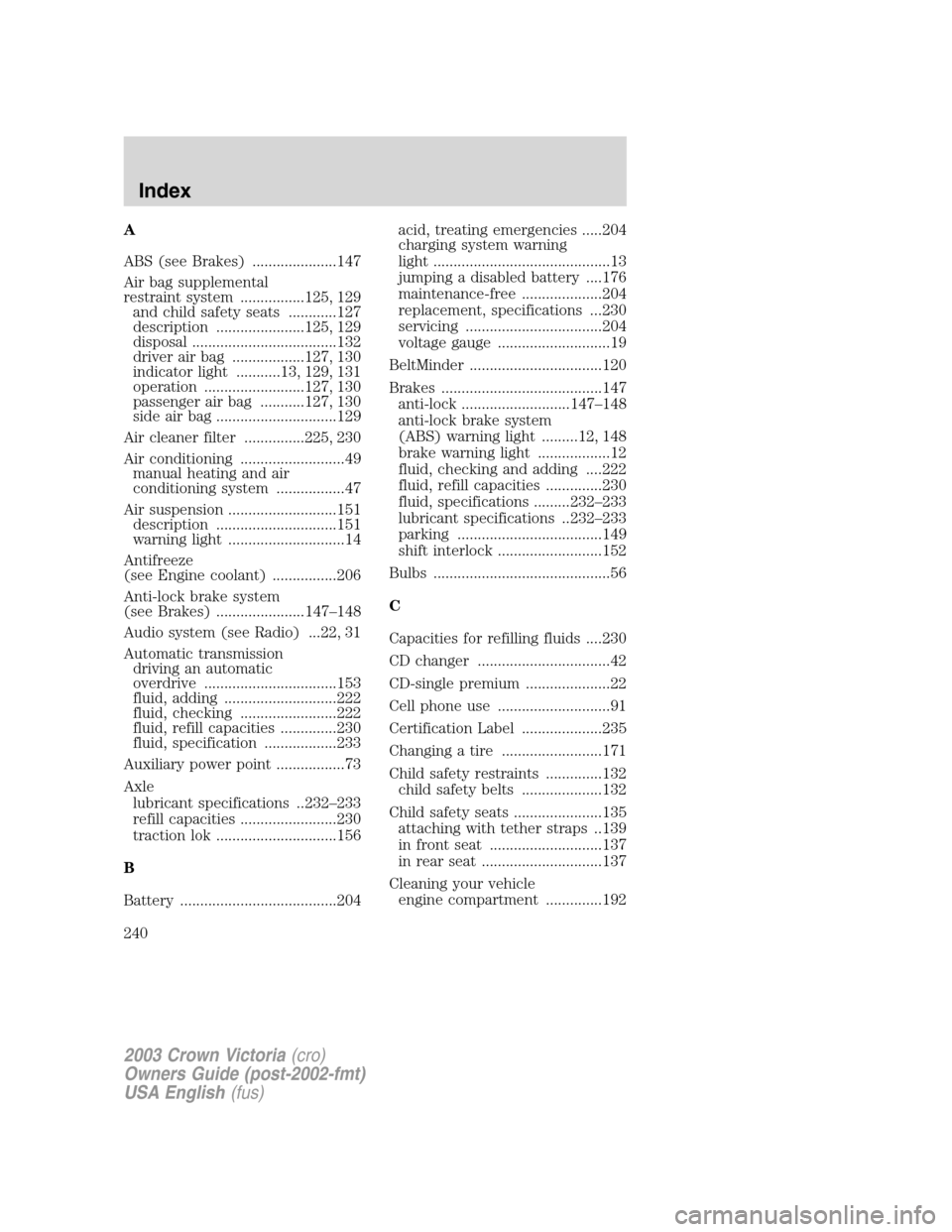
A
ABS (see Brakes) .....................147
Air bag supplemental
restraint system ................125, 129
and child safety seats ............127
description ......................125, 129
disposal ....................................132
driver air bag ..................127, 130
indicator light ...........13, 129, 131
operation .........................127, 130
passenger air bag ...........127, 130
side air bag ..............................129
Air cleaner filter ...............225, 230
Air conditioning ..........................49
manual heating and air
conditioning system .................47
Air suspension ...........................151
description ..............................151
warning light .............................14
Antifreeze
(see Engine coolant) ................206
Anti-lock brake system
(see Brakes) ......................147–148
Audio system (see Radio) ...22, 31
Automatic transmission
driving an automatic
overdrive .................................153
fluid, adding ............................222
fluid, checking ........................222
fluid, refill capacities ..............230
fluid, specification ..................233
Auxiliary power point .................73
Axle
lubricant specifications ..232–233
refill capacities ........................230
traction lok ..............................156
B
Battery .......................................204acid, treating emergencies .....204
charging system warning
light ............................................13
jumping a disabled battery ....176
maintenance-free ....................204
replacement, specifications ...230
servicing ..................................204
voltage gauge ............................19
BeltMinder .................................120
Brakes ........................................147
anti-lock ...........................147–148
anti-lock brake system
(ABS) warning light .........12, 148
brake warning light ..................12
fluid, checking and adding ....222
fluid, refill capacities ..............230
fluid, specifications .........232–233
lubricant specifications ..232–233
parking ....................................149
shift interlock ..........................152
Bulbs ............................................56
C
Capacities for refilling fluids ....230
CD changer .................................42
CD-single premium .....................22
Cell phone use ............................91
Certification Label ....................235
Changing a tire .........................171
Child safety restraints ..............132
child safety belts ....................132
Child safety seats ......................135
attaching with tether straps ..139
in front seat ............................137
in rear seat ..............................137
Cleaning your vehicle
engine compartment ..............192
2003 Crown Victoria(cro)
Owners Guide (post-2002-fmt)
USA English(fus)
Index
Index
240
Page 243 of 248
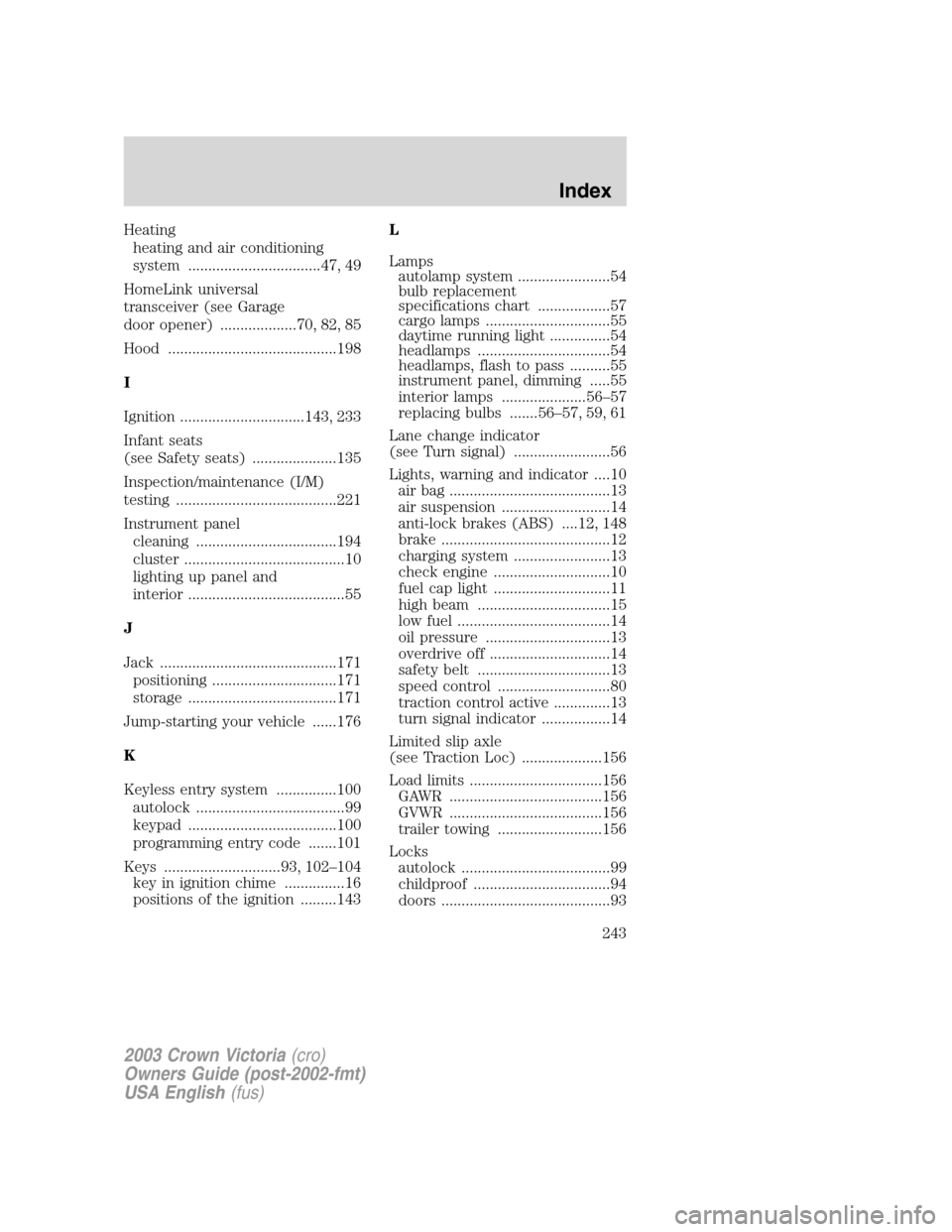
Heating
heating and air conditioning
system .................................47, 49
HomeLink universal
transceiver (see Garage
door opener) ...................70, 82, 85
Hood ..........................................198
I
Ignition ...............................143, 233
Infant seats
(see Safety seats) .....................135
Inspection/maintenance (I/M)
testing ........................................221
Instrument panel
cleaning ...................................194
cluster ........................................10
lighting up panel and
interior .......................................55
J
Jack ............................................171
positioning ...............................171
storage .....................................171
Jump-starting your vehicle ......176
K
Keyless entry system ...............100
autolock .....................................99
keypad .....................................100
programming entry code .......101
Keys .............................93, 102–104
key in ignition chime ...............16
positions of the ignition .........143L
Lamps
autolamp system .......................54
bulb replacement
specifications chart ..................57
cargo lamps ...............................55
daytime running light ...............54
headlamps .................................54
headlamps, flash to pass ..........55
instrument panel, dimming .....55
interior lamps .....................56–57
replacing bulbs .......56–57, 59, 61
Lane change indicator
(see Turn signal) ........................56
Lights, warning and indicator ....10
air bag ........................................13
air suspension ...........................14
anti-lock brakes (ABS) ....12, 148
brake ..........................................12
charging system ........................13
check engine .............................10
fuel cap light .............................11
high beam .................................15
low fuel ......................................14
oil pressure ...............................13
overdrive off ..............................14
safety belt .................................13
speed control ............................80
traction control active ..............13
turn signal indicator .................14
Limited slip axle
(see Traction Loc) ....................156
Load limits .................................156
GAWR ......................................156
GVWR ......................................156
trailer towing ..........................156
Locks
autolock .....................................99
childproof ..................................94
doors ..........................................93
2003 Crown Victoria(cro)
Owners Guide (post-2002-fmt)
USA English(fus)
Index
243